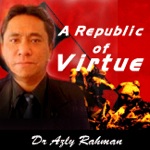UMNO’s karmic cycle

There was a strange but pleasurable sense of “being a Johorean” back in the day, even for a little child like me who almost felt that life back then was about the freedom to roam the kampong/village and walk five miles to the smoke and dust-filled and Segget River-smelling town of Johor Baru.
A REPUBLIC OF VIRTUE
Dr Azly Rahman
Alpha-Omega, a beginning and an end, life coming around in full circle, “wa asal balik asil,” “kalam baru balik pada kalam asal” – all these words came to me this last hour as I pondered upon the origin of Umno in its birthplace, where I, too, grew up fondly in – Johor Baru.
Will Umno die a natural death at age 70 or from circa 1946 when it was born? And will it be buried in its kampong/village near Bukit Senyum in Johor Baru?
I am now imbued with nostalgia of those growing-up years – of place names such as Kampong Mahmoodiah, Wadi Hana, Wadi Hassan, Bukit Senyum, Jalan Meldrum, and of course Stulang Laut where my grandparents (long deceased but fondly remembered) lived – all these bring me back to those memories of the Johor I once knew … birthplace of “Malay nationalism” approved and perhaps sponsored and branded by the colonial masters, so that the channel of exploitation could still be opened in post-colonial times, notwithstanding the rhetoric of “Buy British Last” and the “Look East Policy” of the 1980s Mahathirist era.
Almost weekly to visit relatives, I frequent the vicinity where the Malay para-royalist of Turkish origin Onn Jaafar’s (left) residence was, a British-installed Blenheim-Palace-looking structure (Blenheim was Churchill’s birthplace) that stood on a hill befitting of a home for a British “little-brown brother”.
And that was a Johor historic site where I am quite sure discussions on the formation of Umno were held; almost like a “revolutionary-period French salon” to fuel the opposition to the British proposal of the Malayan Union.
There was a strange but pleasurable sense of “being a Johorean” back in the day, even for a little child like me who almost felt that life back then was about the freedom to roam the kampong/village and walk five miles to the smoke and dust-filled and Segget River-smelling town of Johor Baru.
Fun it was too that one would be constantly exposed to the British names that were installed on the “material landscape of the city” in the form of street names, buildings, etc – names such as Larkin, English College, Woodlands, St Joseph School, Our First Lady of Fatima Church, Lido Beach, and Century Gardens… all these installed at different periods of history.
And of course there were names of human beings such as Sir Abu Bakar, Lady Marcella Ibrahim, and those Malays knighted by the British. And there was the Anglicised JMF or the Johor Military Force that served as private army to the Johor royalty. And of course there is this name in English as well, that is now synonymous with power, dignity, glory, ideology, hegemony and of late unnecessary idiocy – “United Malays National Organisation” or one christened as “Umno”.
I have been a philologically-philosophically-semiotically sensitive person and would be obsessed with thinking about language and reality, how language constructs or destructs reality, and how language is also reality. “From word becomes flesh,” “kun fayakun (be and thou shall become),” and “Om …. ” – all these notions of the primacy of literacy fascinate me.
When I was a child when I would sit quietly, like Miss Rosa Parks, on the T, Hakim Bus, the Seng Hup Bus, or the Johor-Singapore Express bus, or any bus or vehicle I was travelling in and read “signboards” and names of kampongs, towns and cities, of business store-front signs, whatever… get intoxicated by language, and start thinking and thinking about how these places get named and who decides how they are named.
‘High on names’
I was always “high on names” perhaps not getting as high as the “… Lu Gua .. Lu Gua gua cakap sama lu – speaking – “Mat Gian” or “Mat Fit” of Kampong Ubi, Bakar Batu or Tampoi high on shabu or glue or daun ketum or whatever they were smoking … but “high on words, concepts, etc”. Nonetheless, till now I maintain that “highness” for better or for worse …
Back to Umno’s karmic cycle and its rendezvous with moksha (end of cycle of birth and death). How will it all end?
Here is the essence of these notes – how many generations would it take to destroy a seemingly good idea of nationalism and would that destruction be just another phase of a karmic cycle to allow the rebirth of a new style of consciousness that no longer takes nationalism nor its ugly child “communal politics” as a mortal ideology but to allow for a natural birth of the new body with a new spirit?
And that spirit is of supra-nationalism with a Rawles-ian brand of distributive justice, foundationed upon cosmopolitanism and the idea of “multiculturalism and pluralism” in its most intellectual and practical sense – unlike the one ill-understood by Umno.
And how will other communal-based parties in Malaysia (MCA, MIC, etc.) meet their death, too – at a time, as they say in the “Arab Spring”, when revolutions will find each one of us?
**********************************
OUR USUAL REMINDER, FOLKS:
While the opinion in the article/writing is mine,
the comments are strictly, respectfully, and responsibly yours;
present them rationally, clearly, politely, and ethically.
AND – VOTE WISELY!
https://www.facebook.com/#!/azly.rahman
http://azlyrahman-illuminations.blogspot.com/

